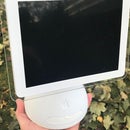Introduction: CNC Telescope, Semi-Nasmyth Mount
This is an 8" Newtonian reflector with a custom built CNC semi-Nasmyth mount. It is primarily constructed of 3/8" plywood and white PVC.
I have a nice 10" GOTO scope, but it is not really portable (scope, tripod, and accessories exceeds 70lbs.). When I was away from home for an extended period of time, I did not ship the GOTO scope with me, so I looked for alternate ways to view the stars (see next step).
I have done some simple woodwork in the past, and had a homebrew CNC router constructed of MDF. I upgraded to a Chinese 6040 router/engraver constructed of Aluminum w/800W water cooled spindle, so I thought this was a good project to get started on.
Step 1: Alternate Scope
I bought the 8" primary mirror, focuser, and secondary on ebay in 2007. I found an old 8" drainage PVC pipe and designed and built this portable/collapsible Newtonian that mounted on a photo tripod (photo 1). The control in pointing the scope is abysmal. I wanted something better.
Most Newtonian mounts pivot somewhere between the primary and secondary mirrors. A Dobsonian mount pivots nearest to the primary mirror. I wanted a scope that pivoted near the secondary, where the eyepiece is located, meaning the observer had to move their body the least amount when moving the scope. I later discovered that having the eyepiece or primary observation through a pivot point is called a Nasmyth mount, or more advanced version with additional mirrors are Coude mounts.
I whipped up a simple idea (3D model) and then did more research...
Step 2: Worm Gears
Worm gear are a tricky beast. Typically the Worm Screw may be smaller in the center and the Worm Gear will have a concave shape across the face of the teeth. Difficult at best to create, at least from my standpoint. So perfection is not necessary, I looked for alternate ways to gain a high gear ratio to maintain a fine control over the telescope pointing.
One day, I noticed the exit chute on a snowblower. The direction is controlled by a toothed gear and a simple screw on a hand crank. I wondered if I could replicate it. I took a 1/8" router bit and expeditiously cut some slots in a piece of scrap wood, bent an old coat hangar in a spiral, and it meshed up although a little crudely (photo 1).
A little further exploration and I found a 1" spring at a hardware store and measured the distance between turns, and routed another sample of scrap wood. Much better results. I placed the spring over a 3/4" rigid conduit and it held in place rather well (photo 2). I later replaced the conduit with a wooden dowel to keep the aesthetics in line with a wooden theme. So, this became my crude worm gear.
Step 3: Aethetics
My original design had some requirements:
1. Made of wood (ease of machining and cost of materials)
2. Keep the eyepiece as stationary as possible
3. Look cool (how do you define that?)
After some initial research and some success with the Worm Gear, I added a couple other ideas to the design requirements #3:
3a. Somewhat resemble a sextant (photo 1)
3b. Maybe have a steampunk feel
3c. Lightweight
3d. Portable
3e. Collapsible (photo 2)
Some design decisions just fell into place. Wood is lightweight, but to make it lighter, add some aesthetic holes. The altitude of the scope needs to rotate between 0-90 degrees, so a quarter of a circle, somewhat resembles a sextant. The size of my router is 60x40cm, but effectively smaller due to machine limits and clamping, so I was left with about 15x23 inches. This means that some of the larger parts will have to be hinged, thus making it collapsible.
Step 4: Updated Design
I updated the 3D model as best I could, coloring is generic tan to simulate untreated pine. This design shows a tabletop tripod so that the telescope could be placed on a picnic table or other standard height outdoor table. The final photos show it on a Meade Giant Field Tripod from my 10" scope.
Another thing that fell into place: The focal distance from the Primary to the secondary really dictated the size of the quarter circle, and it so happens that this size and the spacing of the spring for the worm screw I found ended up needing 90 teeth to move it 90 degrees, thus making one revolution of the hand crank equal to one degree of Altitude adjustment.
Step 5: Cut and Modify
My process involved many tools:
3D design and rendering: Lightwave 3D (I have had a license since the 90s)
Line art drawings: Inkscape (Free open source)
G-Code: Gcodetools (plugin for inkscape), and a text editor
CNC Milling: 6040 router and Mach 3 (demo mode, 500 line code max)
I designed some things, cut some things, redesigned some things, cut more things... It was an iterative process that needed refinement along the way. Everything is not perfect yet, but some day it may be reproducible. I found cutting all the holes left me with a lot of spare round pieces, so I used a few for handles, and one of the large ones became the mirror cover (later picture).
Step 6: Turn Baby, Turn!
The lower part of the base that is stationary is two halves, with 180 teeth (photo 1). A 4" lazy-susan bearing is in the center, the original idea was to put a nautical compass in the center hole. The upper plate is made of three folding pieces. The worm screw will be mounted to the top plate, which is slightly larger than the bottom plate, to protect the teeth from exposure. So the worm screw turning against this will get two degrees of azimuth adjustment per revolution of the hand crank. The lower half has 8 holes and the upper 9 holes. This difference gives the appearance of the waxing and waning cycles of the moon as it rotates (photo 2). The upper plate has three additional hole sizes around the perimeter for eyepieces: 1", 1.25" and 2" holes.
Step 7: Exceeding the Limits
Three of the pieces exceeded the size limit of my router. To overcome this obstacle, I laid out two pieces next to each other with one flipped around the extra long way (180 degrees). I then programmed the router to only cut the bottom half of that design to stay within the size limit. After the first half cut, I rotated the working piece 180 degrees and ran the program again, effective exceeding the size limit.
Step 8: Nearly Complete
This first photo shows the majority of larger pieces cut and assembled. There was a lot of fine tuning to be done, but I had a star party to go to, and it attended as-is. Another person took a photo at the star party and sent it to me, where I compared it to the 3D design (photo 2, side by side).
Step 9: Finishing
After the star party, I gave everything a stain and seal, and painted the white PVC black. I added an 8" cover to the primary mirror and routed a nice astronomical chart on it. Some room for improvement is that it still wobbles a little. I think I may have to replace the 3/8" top plate with 1" plywood for a firmer stand.
I added the animated GIF (photo 2) to show how the semi-Nasmyth mount works. As the telescope changes altitude, the eyepiece stays in the same location as a true Nasmyth mount would, but for a shorter or taller person, the eyepiece can be tilted up or down, thus making it a semi or psuedo-Nasmyth mount. Of course the observer has to move around the scope as the azimuth changes (horizontal rotation/swivel).
Step 10: Computer Files
Here are some of the computer files. Again, these are not accurate to any specification, they were designed and modified on the fly. The base .STL file is from LightWave3D, mainly for visualization. When I dig out the G-Code used on my router, I will attach those as well.
Attachments

Runner Up in the
CNC Contest 2016

Participated in the
First Time Authors Contest 2016














